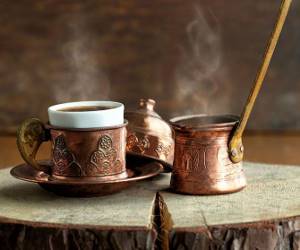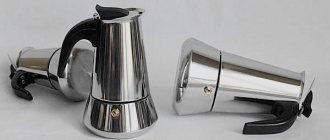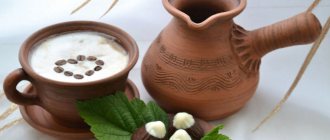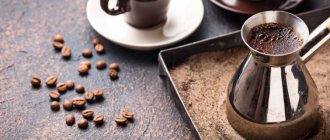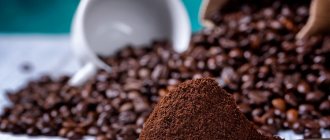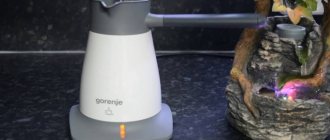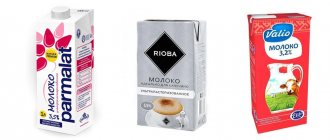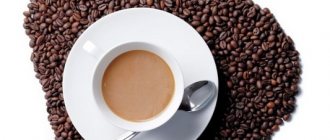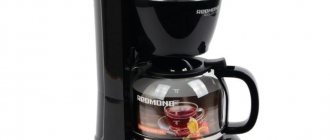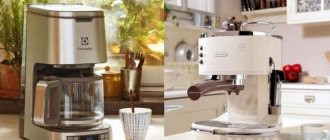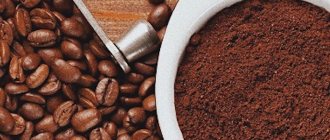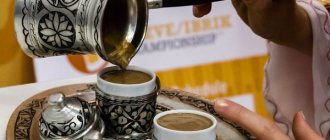Properly selected coffee grinders and adherence to brewing technology and recipes allow you to prepare real Turkish coffee. Only in this combination will the resulting drink have an unforgettable rich taste, convey a charge of vivacity and good mood, and will retain all the aromatic substances contained in the roasted grains. There is a wide range of devices for making natural coffee; without certain knowledge, you can easily make a mistake in your choice and be disappointed in your purchase.
Properly selected coffee grinders and adherence to brewing technology and recipes allow you to prepare real Turkish coffee.
How to choose a Turk for brewing coffee
How to choose a Turkish coffee pot among the variety of products so that it is not only comfortable, but also produces only the highest quality coffee? Expert advice will help you make the right purchase.
- The traditional Turk has a cone shape. In it, the grains settle faster, and the foam becomes as clean as possible.
- The thicker the bottom and walls, the better. In such a Turk, uniform heating occurs, and the prepared coffee remains hot longer.
- To get a classic drink, you need to choose containers designed for 1-2 cups.
- For electric stoves, dishes with a smooth and flat bottom are more suitable, for gas stoves - with a rounded bottom.
- The copper Turk is the most practical, and its price is affordable for all buyers.
- Beginners can opt for transparent containers, which will help control the process and avoid coffee boiling over.
- The longer the handle, the more convenient it is. The heat-resistant material will allow you to use the cookware without using oven mitts. Thanks to the removable handle, you can wash the dishes better after cooking.
- In high Turks, the boiling process occurs more slowly, so the drink becomes richer and more aromatic.
- The built-in spout makes it easy to pour coffee into cups. The wider it is, the more convenient it is to do this.
- To achieve an ideal result, the diameter of the neck should be 2-3 times smaller than the diameter of the bottom.
- For a large family or group of friends, Turks with a volume of 500 ml or more are suitable.
The right Turk for your favorite coffee
The cezve (or Turka, as it has been commonly called in Russia since the times of the Russian-Turkish wars) is an ancient invention. It is a close relative of the dalle, the same saucepan with a lid and a curved spout that Bedouin nomads carried with them across the desert.
And, it would seem, what could be better than the good old Turks? But in reality, choosing it is not so easy. We tell you how not to miss, together with our expert captester Ilya Goncharov.
Why is copper best?
Metal is the most traditional material for making a cezve. Copper, steel and aluminum are most often used in production, and brass and bronze are much less common. Quite often, cezves are created by craftsmen who work with ceramics.
Copper
Historically, Turks made from copper, and even today, copper vessels are considered the most appropriate choice for preparing coffee. Our expert explained why:
- Copper has high thermal conductivity.
This means that the heat coming from below is quickly distributed along the walls, which allows the coffee to heat evenly. And this allows you to preserve the flavor of the coffee. When removed from the heat, the copper cezve cools equally evenly, preventing the coffee from over-extracting. - Coffee in a copper cezve can be brewed on sand, gas and electric stoves
(but not on induction). - Finally, it's beautiful.
Even the simplest and cheapest hammered copper pot always looks authentic and adds zest to the interior of any kitchen.

True, there are nuances. The light copper cezves hanging in clusters above the counters of the Istanbul Grand Bazaar were created using the stamping method. They are very cheap and nice to look at, but the quality of coffee they produce is not very consistent due to the very thin walls. It is better to choose Turks created by forging: their bottom and walls are much thicker.
Another important nuance: the inside of the Turk must be coated with food-grade metal (stainless steel, tin or silver), which eliminates the interaction of the copper itself and the drink.
Aluminum
This is a familiar version from Soviet childhood, which was used not only for making coffee, but also for heating milk or cooking a portion of porridge. Aluminum Turks are incredibly light (which allows them to be used as a hiking option), cheap and very unpretentious. True, they also have significant disadvantages: aluminum, although covered with an oxide film, easily and happily enters into chemical reactions with the acids contained in natural coffee, and can “give” a metallic taste to the drink.

Steel
Coffee snobs look at steel Turks with contempt, and, by the way, in vain. They have a lot of advantages: they are durable, inexpensive, do not enter into unpredictable reactions with drinks and, to the delight of owners of induction cookers, do not require any adapters.
Ground coffee Lebo “Prince”, for Turkish, 100 g 79 rub.
Ground coffee Lavazza “Crema e Gusto”, 250 g 258 rub.
Ground coffee Lavazza “Qualita Oro”, in a tin can, 250 g 400 rub.
Ground coffee Paulig “Mokka”, 250 g 157 rub.
Ground coffee Lebo “Extra”, for Turkish, 75 g 61 rub.
Ground coffee Coffesso “Classico Italiano”, 5 sachets -25%
110 rub. 146 rub.
Ground coffee Jardin “Espresso di Milano”, 250 g 221 rub.
Ground coffee Fresco Arabica Barista, for brewing in a cup, 100 g -50%
90 rub. 179 rub.
Buy ground coffee on TEA.ru
And the main disadvantage of such cezves is that steel is a stubborn working material. It is difficult to create a classic shape with a narrowed neck, ideal for coffee extraction. In addition, the thermal conductivity of steel is much worse than that of copper or aluminum.
Ceramics
Clay, like no other material, is flexible to experimentation. The master can easily adjust the thickness of the walls, the width of the neck and bottom of the vessel. This allows you to create an ideal shape from the point of view of making coffee.
Due to the ability of clay to retain heat for a long time, it is not necessary to let the coffee in such a turk become foamy; you can turn off the stove earlier and wait for the coffee to “reach” on its own. This is also a disadvantage of ceramics: the cezve takes a long time to cool down and a drink that is not poured into cups immediately can be over-extracted and become bitter.
A significant disadvantage of any ceramics: its fragility. Even the most durable, heat-resistant cordierite clay can crack if handled carelessly. Turks made of metal ceramics (for example, Mozambique cezve) are more durable.

Size matters
Do you like your morning coffee alone or do you prefer to brew it for two or for a group? This is something to consider when choosing a cezve.
The classic volume of “Egoist Turks” for making oriental coffee is 100-150 ml (1 teaspoon of coffee per 75 ml of water). If you prefer a large cup, then you can focus on a volume of 170-250 ml. For two cups of coffee, respectively, you need a volume of 250-350 ml. Well, for several servings - a large cezve from 400 ml.
However, professionals advise taking a small pot: the coffee heats up more evenly and tastes better, although you will have to stand at the stove a little longer.
Important: brewing coffee for one person in a large pot is not recommended. Ideally, water is always poured “under the neck” so that the area of contact between the drink and air is minimal.
Choosing a form
The canonical shape of the cezve: a cone with a wide bottom and a narrow neck. A narrow neck is needed for a reason. It is thanks to it that the surface of contact between coffee and air narrows. Thanks to the foam “cap,” the drink retains the volatile essential oils responsible for the notorious coffee aroma.
Pay attention to the wall thickness and handle material
“The standard thickness of the walls and bottom of a metal (copper) cezve should not exceed 1.5 mm. In rare cases, the bottom may be thicker: as a rule, this is an option for making coffee on sand,” explains Ilya Goncharov.
The Turkish handle is made of metal, plastic and wood. The truth of life is that metal heats up when cooking (get an oven mitt!), while plastic heats up more slowly, but can smell unpleasant. The best option was and remains a cezve with a wooden handle angled upward.

First date: where to start getting acquainted with a new jazz
So, the cezve has been purchased, the coffee has been ground, all that remains is to brew it. Take your time.
Before the first preparation, thoroughly wash the Turk with water without using detergents, and then boil water with a slice of lemon in it (no need for aluminum ones) - this has a disinfecting effect. After this, you should boil a test cup and pour it out: this will cover the inner walls with a film of essential oils. And after all this, you can enjoy preparing your favorite drink.
Should I wash essential oils from Turks or not? We will not give a definite answer to this question, because all our authors and experts act differently. For example, how do you wash your accessory?
Rating of the best Turks for making coffee
| Nomination | place | Name of product | price |
| The best copper turks | 1 | Stanitsa “Mednaya”, 500 ml | 989 ₽ |
| 2 | Turk Mayer & Boch 750 | 810 ₽ | |
| 3 | Stanitsa "Grace", 350 ml | 918 ₽ | |
| 4 | TimA TU-550s | 724 ₽ | |
| 5 | Mallony “Oriental Beauty”, (art. 985223) | 905 ₽ | |
| The best stainless steel Turks | 1 | Vitesse “Turguoise”, 685 ml VS-8634 | 790 ₽ |
| 2 | Fissman, 550 ml. 3305 | 1 259 ₽ | |
| 3 | Padia, 340 ml (art. 6100-23) | 286 ₽ | |
| The best ceramic turks | 1 | Ceraflame Ibriks New 500 ml. D9375 | 2 417 ₽ |
| 2 | Gutenberg "Oriental Mosaic", 200 ml (C09-200) | 2 069 ₽ | |
| 3 | Ceraflame “Ibriks Hammered” (art. D9409) | 2 890 ₽ |
Comparison of brass and copper cookware
For home use
It is generally accepted that the correct coffee pot is copper, but alloys are more often used for manufacturing than pure metals. As a rule, brass is preferred for Turks used at home.
In this regard, copper products are found on sale approximately four times less often. The cost of brass utensils is two and a half times higher than that of copper. The shops sell handicrafts and industrial designs.
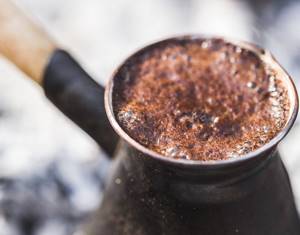
Pros and cons of materials
For comparison, note the following:
- Periodically, the copper pot for making coffee is renewed, as the material absorbs odors, changes color and acquires carbon deposits.
- If the inner tin coating of a brass pot is damaged, it will oxidize and the pot will have to be replaced.
- Copper utensils do not leave dents when dropped; they have high strength properties.
- Thanks to the thickened bottom, the brass container does not tip over and stands stably on the surface.
- Copper containers are made cone-shaped, so the coffee beans fully impart their taste and aroma.
Many people decide to choose a copper coffee pot due to its obvious advantages.
Interesting! How many cups of coffee will be produced from 1 kg of beans?
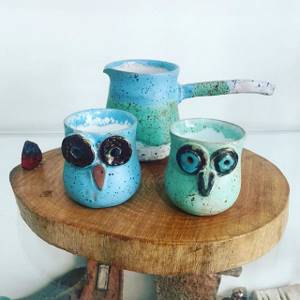
The best copper turks
Stanitsa “Mednaya”, 500 ml
Rating: 4.9
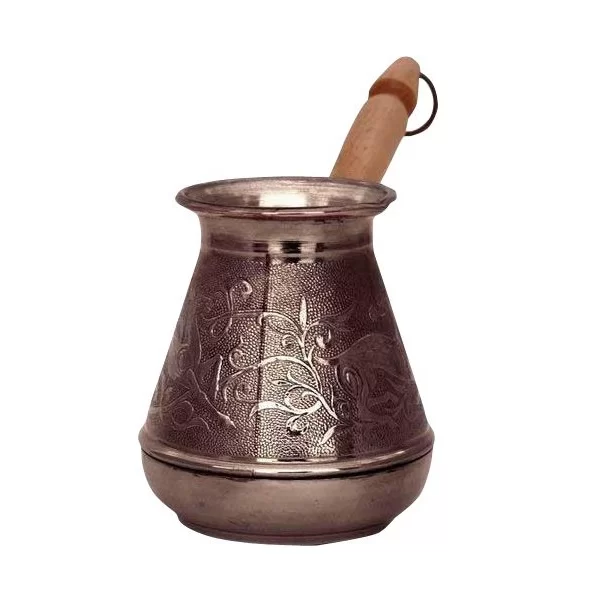
The first place is taken by a classic-shaped Turk with a volume of 500 ml. It is made from copper coated with a protective layer on top. The interior is treated with food-grade tin, which prevents oxidative processes and makes the model safe to use for health. A narrow neck contributes to the preparation of a tart, aromatic drink.
The handle is quite long, comfortable, and made of natural wood. It will help make the coffee preparation procedure more comfortable and eliminate the risk of burns. With the help of a metal ring, the Turk can not only be stored on a shelf, but also hung on a hook. The sophisticated design makes it a stylish piece in the kitchen. Turka will be an excellent gift option for coffee lovers for any occasion.
Many users noted the excellent appearance and preparation of truly real coffee with an invigorating aroma and richness. Turka is highly durable, resistant to deformation, and the inner layer is not scratched. An important quality is the ability to wash in the dishwasher.
Advantages
- for making coffee of any kind;
- heat-resistant wooden handle;
- presence of a spout;
- safety;
- ideal ratio of bottom and neck diameters;
- Durable internal tin lining.
Flaws
- not detected.
Turk Mayer & Boch 750
Rating: 4.8
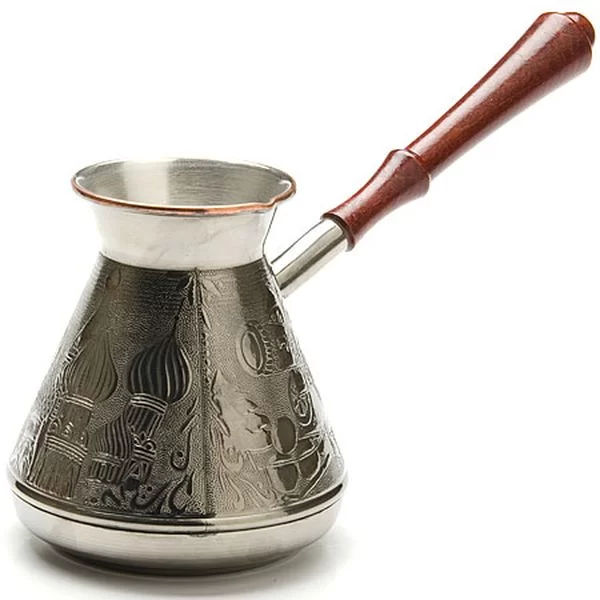
The second place in the ranking is taken by the Turkish brand Mayer & Boch. It is made of high quality copper with an outer plating of black nickel. The volumetric design attracts attention and makes coffee making more enjoyable. The interior is coated with food-grade tin for safe use of copper cookware.
The Turk ensures uniform heating. A narrow neck allows the powder to quickly settle to the bottom and makes the foam more free from impurities. The high side creates optimal conditions for adding richness to the drink and preserving its aromatic properties. The carved wooden handle allows you to quickly remove the Turk from the stove at the moment of boiling. It does not heat up and prevents burns.
The model can be used on all hobs except induction. It is not recommended to clean with abrasive agents or in the dishwasher. Many noted that the Mayer & Boch 750 Turk is suitable for making coffee for a large company; it produces a drink both according to the traditional recipe and according to the author’s one.
Advantages
- high quality copper;
- heat insulating handle;
- food grade tin coating;
- high sides – 13 cm;
- nice design;
- affordable price.
Flaws
- not detected.
Types of Turks for coffee
Coffee is one of the most popular drinks all over the world. On different continents, different peoples have their own traditions and cooking secrets. The type of Turks is also different, of which there are several dozen today. They are different in material, shape, principle of operation and operation. The main criterion for distinction remains the material used to make the vessel, which directly affects the quality characteristics of the cezve. Let's take a closer look at the main types of Turks, what materials they are made of, their advantages and disadvantages.
View this post on Instagram
Posted by Design Fashion Studio (@design.fashion.studio) Feb 9, 2021 at 2:34 PST
Options for metal turks
Metal Turks are the most common due to such metal properties as high thermal conductivity, strength, durability and wear resistance. In the production of this product, many different metals and their alloys are used, each of which has its own special characteristics:
The key to delicious coffee is the shape of the vessel, bottom and neck
Before choosing a Turk for brewing coffee, look at the shape of the pot. The aroma and taste of the drink depends on it. When choosing, consider the following points.
Interesting! How many spoons of coffee should I put in a Turk?
If the bottom of the vessel is wider than the top, then the walls of the Turka have a steep slope. This form is the best, as it prevents the heated grounds from rising upward. The mass will concentrate at the bottom, as a result the coffee will brew better.
A good Turk should have a narrow neck. This top allows you to create a dense foam cap on the surface, which plays the role of a kind of plug. The aroma of the brewed drink and essential oils do not disappear through it. This will allow you to cook a delicious treat.
The size of the bottom of the dish should be twice the diameter of the neck. This bottom heats the coffee evenly and maximizes the flavor.
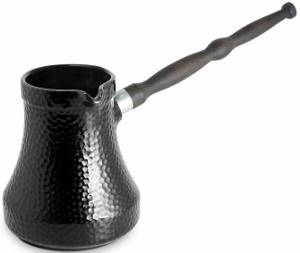
Helpful Tips and Reminders
Based on the above, we can draw a conclusion about how to choose a Turk for coffee.
This must be done responsibly and carefully; there are many options. The best choice for gourmets would be a copper vessel of rich color, and for people who prefer environmentally friendly materials - a ceramic one.
The fewer decorative elements on a product, the better. It’s good if there is a removable, non-heating handle - it will be easier to wash the container.
Do not use abrasive or aggressive substances for cleaning, otherwise the coffee will absorb their smell. After using it at home, rinse the vessel with hot water while wiping it with a sponge.
In general, which Turk is better to brew coffee in is an individual choice.
Interesting! How many grams of coffee are in a teaspoon and a tablespoon?
